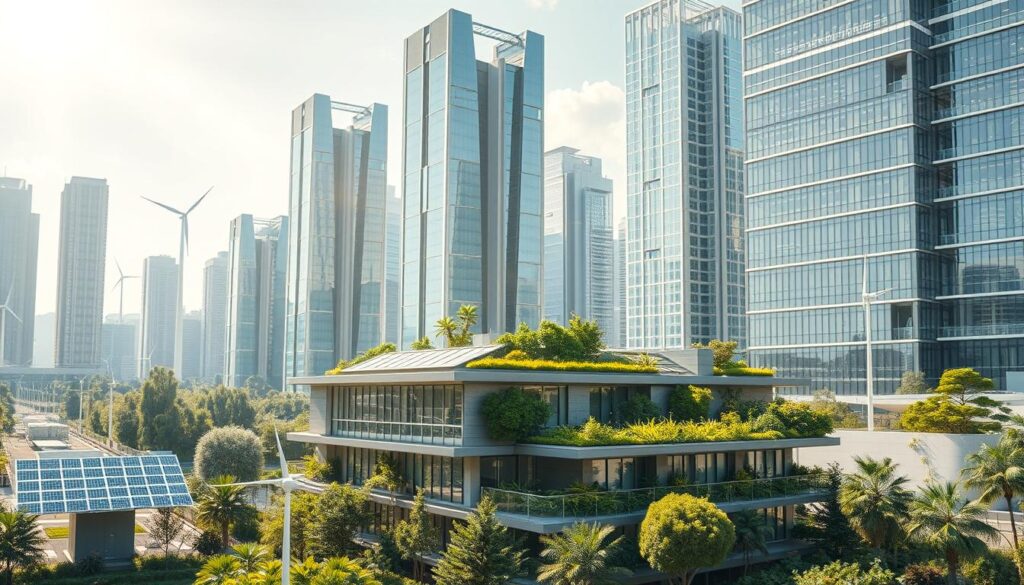The construction industry is on the cusp of a revolution, with sustainable construction methods leading the charge. The USA is witnessing a significant shift towards eco-friendly building practices, driven by technological advancements and a growing emphasis on environmental sustainability.
Technologies like AI, IoT, and BIM are transforming the construction landscape, enabling more efficient, cost-effective, and sustainable projects. As the industry continues to evolve, it’s crucial for professionals to stay updated on the latest innovations. For instance, the use of sustainable building materials is becoming increasingly popular, with a focus on minimizing ecological impact.
Key Takeaways
- The construction industry is adopting sustainable practices at a rapid pace.
- Technologies like AI and IoT are driving efficiency and sustainability in construction.
- BIM is revolutionizing the way construction projects are planned and executed.
- Sustainable building materials are gaining traction, reducing environmental impact.
- Staying updated on the latest trends is crucial for industry professionals.
Overview of Next-Generation Building Technologies
With the global construction market projected to grow significantly, driven by technological innovation and sustainability efforts, understanding next-generation building technologies is more crucial than ever. The industry is witnessing a paradigm shift towards more sustainable and efficient practices.
Defining Next-Generation Building Tech
Next-generation building technologies encompass a broad range of innovations, including green building technologies and energy-efficient building materials. These advancements are designed to reduce the environmental footprint of buildings while enhancing their functionality and performance.
“The future of construction lies in sustainability and technology,” as echoed by industry leaders, highlighting the importance of integrating green technologies into building practices.
Importance in Today’s Construction Landscape
The significance of next-generation building technologies in today’s construction landscape cannot be overstated. With the increasing demand for sustainable and energy-efficient buildings, these technologies are becoming essential for developers and builders.
- Enhanced energy efficiency
- Reduced environmental impact
- Improved building performance
According to recent reports, the adoption of green building technologies is on the rise, driven by both regulatory requirements and consumer demand for more sustainable options.
As the industry continues to evolve, it is clear that next-generation building technologies will play a pivotal role in shaping the future of construction.
Sustainable Building Practices
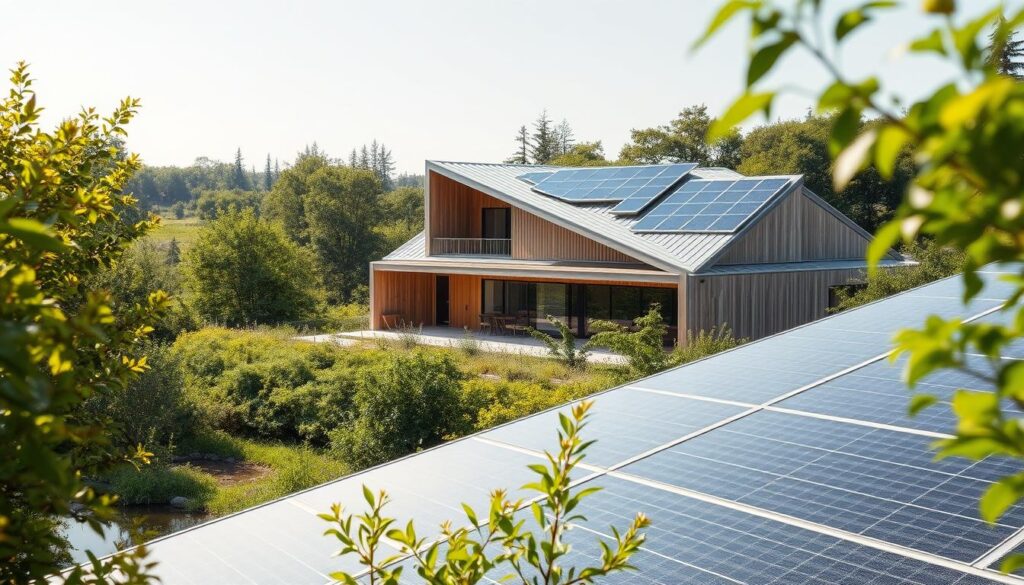
Embracing sustainable building practices is no longer optional; it’s a necessity for reducing the environmental footprint of the construction industry. As the industry continues to grow, the importance of adopting eco-friendly construction practices and sustainable construction methods becomes increasingly evident.
The construction industry is a significant contributor to global carbon emissions, making sustainable practices essential for reducing environmental impact. By focusing on green materials, energy efficiency, and waste reduction, the industry can significantly lower its ecological footprint.
Green Materials and Energy Efficiency
One of the key aspects of sustainable building practices is the use of green materials. These materials are sourced and manufactured using methods that have a lower environmental impact compared to traditional materials. Examples include reclaimed wood, bamboo, and low-carbon concrete. Incorporating these materials into building projects not only reduces the environmental impact but also enhances the sustainability of the structure.
Energy efficiency is another critical component of sustainable building practices. This involves designing buildings that consume less energy while maintaining optimal performance. Strategies include using energy-efficient appliances, improving insulation, and incorporating renewable energy sources such as solar and wind power. For more information on emerging green building innovations, visit https://worldcivilsociety.com/emerging-green-building-innovations/.
| Green Material | Environmental Benefit | Cost Comparison |
|---|---|---|
| Reclaimed Wood | Reduces deforestation | Higher upfront cost, but long-term savings |
| Bamboo | Fast-growing, renewable resource | Competitive pricing with traditional wood |
| Low-Carbon Concrete | Reduces carbon emissions | Slightly higher cost than traditional concrete |
Innovations in Waste Reduction
Innovations in waste reduction are also playing a crucial role in sustainable building practices. Construction projects generate a significant amount of waste, and finding ways to minimize this waste is essential. Techniques such as modular construction, prefabrication, and recycling construction materials are becoming increasingly popular. These methods not only reduce waste but also improve construction efficiency and reduce project timelines.
By adopting sustainable building practices, the construction industry can significantly reduce its environmental impact. It’s a step towards a more sustainable future, and one that is becoming increasingly important as the industry continues to evolve.
Smart Buildings and IoT Integration
The integration of Internet of Things (IoT) technology in building design is revolutionizing the way we manage and interact with buildings. This technological advancement is not only enhancing building management but also significantly improving the experiences of residents through smart home innovations.
How IoT is Transforming Building Management
IoT technology is being increasingly adopted in construction for enhanced building management. By integrating IoT devices, buildings can now be managed more efficiently, with real-time monitoring and data analysis enabling proactive maintenance and reducing operational costs.
Key benefits of IoT in building management include:
- Enhanced energy efficiency through smart energy management systems
- Improved security with IoT-enabled surveillance and access control
- Predictive maintenance, reducing downtime and extending the lifespan of building systems
Benefits of Smart Technology for Residents
Smart home innovations are not just about efficiency; they also significantly enhance the living experience for residents. With IoT-enabled devices, residents can control lighting, temperature, and entertainment systems remotely, creating a more comfortable and personalized living environment.
The integration of smart technology in homes is leading to:
- Increased convenience through voice-controlled systems and mobile apps
- Enhanced comfort with automated climate control and personalized settings
- Improved safety with smart security systems and alerts
As IoT continues to evolve, we can expect even more sophisticated smart building technologies that will further transform the way we live and work.
Advanced Construction Materials
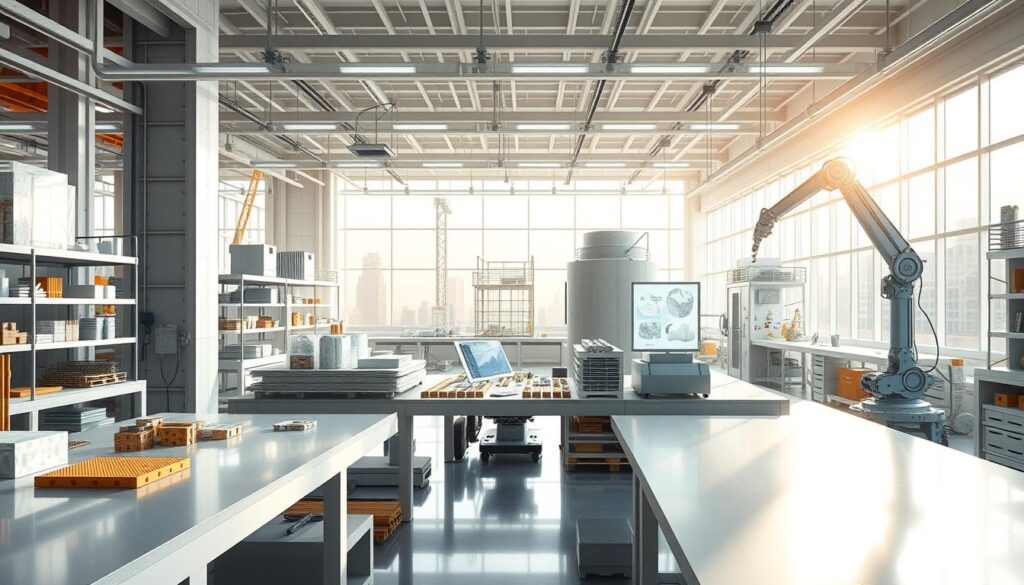
The use of advanced materials in construction is becoming increasingly important for creating resilient and sustainable structures. As the industry continues to evolve, the development of new materials plays a crucial role in enhancing building performance and reducing environmental impact.
Innovations in Concrete and Steel
Concrete and steel are among the most widely used materials in construction. Recent innovations have focused on improving their sustainability and performance. For instance, high-strength concrete is being used to create thinner, lighter structures that require less material. Similarly, advancements in steel production have led to the development of high-strength, low-alloy steel, which offers improved durability and resistance to corrosion.
| Material | Traditional Characteristics | Advanced Characteristics |
|---|---|---|
| Concrete | High compressive strength, durable | High-strength, self-healing, sustainable |
| Steel | High tensile strength, ductile | High-strength, low-alloy, corrosion-resistant |
The Rise of Green Alternatives
In addition to advancements in traditional materials, there is a growing trend towards the adoption of green alternatives. These materials are designed to reduce environmental impact while maintaining or improving building performance. Examples include recycled materials and sustainably sourced timber.
For more information on innovative construction materials, visiting resources like ConExpo-Con/Agg can provide valuable insights into the latest developments in the field.
Modular and Prefabricated Construction
The construction industry is witnessing a significant shift towards modular and prefabricated construction methods, driven by the need for sustainability and efficiency. This approach involves manufacturing building components in a factory before assembling them on-site, offering numerous benefits over traditional construction techniques.
Benefits of Modular Design
Modular design offers several advantages, including improved quality control, reduced waste, and enhanced sustainability. By constructing modules in a controlled environment, manufacturers can ensure higher quality and precision, minimizing the risk of on-site errors.
- Eco-friendly materials: Modular construction often incorporates sustainable materials, reducing the environmental footprint.
- Energy efficiency: Modules can be designed to be highly energy-efficient, contributing to greener buildings.
- Reduced construction time: With components manufactured off-site, on-site assembly can be completed much faster than traditional construction methods.
Impact on Construction Timelines
Modular and prefabricated construction significantly impacts construction timelines by reducing the time required for on-site assembly. This efficiency is due to the simultaneous preparation of the building site and the manufacturing of modules, allowing for a streamlined construction process.
- Pre-manufactured modules can be assembled on-site in a matter of weeks, compared to months with traditional methods.
- The reduced on-site labor requirement minimizes delays caused by weather conditions or labor shortages.
- Modular construction allows for the overlap of manufacturing and site preparation, further accelerating the project timeline.
By adopting modular and prefabricated construction methods, the industry can move towards more sustainable construction practices, reducing environmental impact while improving efficiency and quality.
3D Printing in Construction
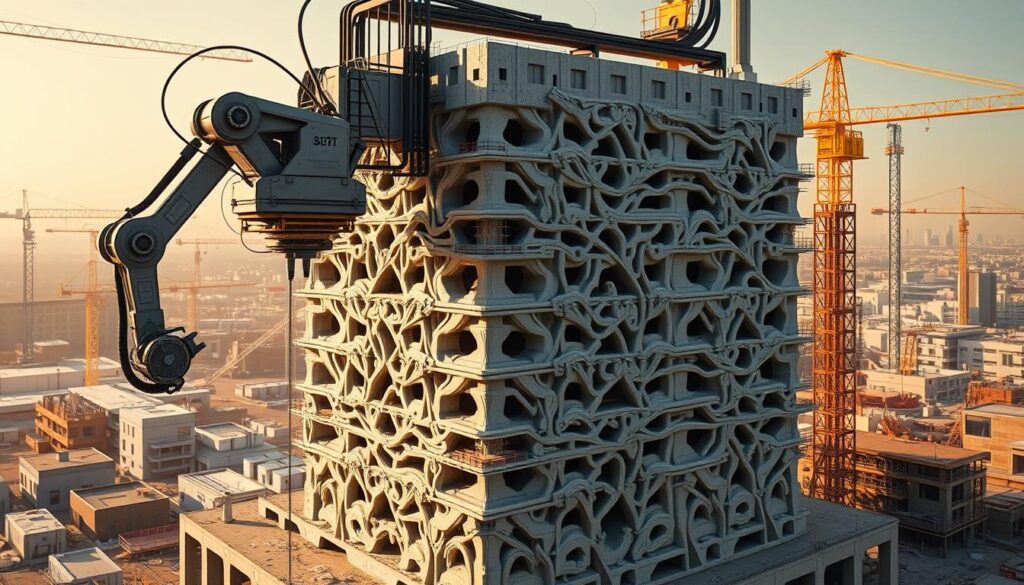
3D printing is transforming the construction landscape by offering unprecedented efficiency and innovation. This technology has the potential to revolutionize the way buildings are constructed, making the process faster, cheaper, and more environmentally friendly.
The Future of On-Site 3D Printing
The future of 3D printing in construction is promising, with on-site 3D printing being a significant area of development. This involves printing building components directly on the construction site, reducing transportation costs and environmental impact. The integration of AI in the construction industry is further enhancing the capabilities of 3D printing technology.
On-site 3D printing can significantly reduce construction timelines and improve accuracy. It also opens up new possibilities for complex architectural designs that would be difficult or impossible to achieve with traditional construction methods.
Case Studies of Successful Projects
Several successful projects have demonstrated the potential of 3D printing in construction. For instance, a project in the USA utilized 3D printing to construct a series of affordable housing units, showcasing the technology’s ability to reduce costs and construction time.
| Project | Location | Benefits |
|---|---|---|
| Affordable Housing | USA | Reduced construction time, lower costs |
| Commercial Building | Dubai | Increased design complexity, improved sustainability |
| Bridge Construction | Netherlands | Enhanced durability, reduced material waste |
These case studies highlight the versatility and benefits of 3D printing in construction, from reducing costs and construction time to enabling complex designs and improving sustainability.
Building Information Modeling (BIM)
Building Information Modeling is redefining the construction landscape by enhancing collaboration and data integration. BIM technology allows for the creation of detailed digital representations of physical and functional characteristics of buildings, making it an indispensable tool in modern construction.
Advantages of BIM in Project Management
The use of BIM in project management offers numerous benefits, including improved collaboration among stakeholders. By providing a shared platform for architects, engineers, contractors, and owners, BIM facilitates better communication and reduces errors.
BIM also enables enhanced data integration, allowing for the incorporation of various data sources into a single model. This integration supports more accurate project planning, execution, and monitoring.
- Enhanced visualization of the project
- Improved clash detection and resolution
- Better cost estimation and management
Integration with Other Technologies
BIM is not a standalone technology; it is designed to integrate with other construction technologies, such as IoT devices and drones. This integration creates a more connected and efficient construction process.
For instance, BIM can be used in conjunction with IoT sensors to monitor building performance in real-time, allowing for predictive maintenance and reducing the risk of equipment failures.
By embracing BIM and its integrations, the construction industry can look forward to increased productivity and reduced project timelines.
Energy Efficiency Technologies

Energy efficiency technologies are revolutionizing the way buildings are designed and operated. These advancements are crucial for reducing energy consumption and promoting sustainability in the construction industry.
Solar Power Innovations
The integration of solar power into building design has seen significant advancements. Bifacial solar panels, for instance, can increase energy output by up to 25% by capturing sunlight on both sides of the panel. Additionally, innovations like building-integrated photovoltaics (BIPV) are becoming more prevalent, allowing solar panels to be integrated directly into building facades and rooftops.
For more insights on the latest trends in energy-saving technologies, visit National Efficiency.
Energy Storage Solutions
Energy storage solutions are critical for maximizing the benefits of solar power and other renewable energy sources. Advanced battery technologies like lithium-ion batteries are becoming more efficient and affordable, enabling buildings to store excess energy generated during the day for use at night or during peak demand periods.
| Technology | Description | Benefits |
|---|---|---|
| Bifacial Solar Panels | Captures sunlight on both sides | Increased energy output |
| Building-Integrated Photovoltaics (BIPV) | Integrates solar panels into building design | Aesthetic and functional integration |
| Lithium-Ion Batteries | Advanced energy storage | Improved efficiency and affordability |
These energy efficiency technologies are pivotal in shaping the future of sustainable building practices. By embracing innovations in solar power and energy storage, the construction industry can significantly reduce its environmental footprint.
Virtual Reality and Augmented Reality
VR and AR are transforming the construction landscape by enhancing design, planning, and stakeholder engagement. These technologies are not just innovative tools; they are revolutionizing how construction projects are visualized, designed, and executed.
Enhancing Design and Planning Processes
The integration of VR and AR into construction projects significantly enhances the design and planning phases. By allowing stakeholders to visualize projects in a highly immersive and interactive environment, these technologies facilitate better decision-making and reduce the likelihood of costly errors.
For instance, architects and designers can use VR to create detailed, interactive models of buildings, enabling clients to experience the design before it’s built. This not only improves client satisfaction but also allows for real-time feedback and adjustments, streamlining the design process.
As noted by industry experts, the adoption of VR and AR can lead to significant improvements in project outcomes. According to a report by Cemex Ventures, these technologies have the potential to change the construction industry by enhancing collaboration, reducing costs, and improving project timelines.
Benefits for Stakeholders
The benefits of VR and AR in construction extend to all stakeholders involved in a project. For clients, these technologies offer a more engaging and immersive experience, allowing for a deeper understanding of the project’s scope and timeline.
- For contractors, VR and AR can improve site planning and logistics, reducing the risk of delays and cost overruns.
- For architects and designers, these technologies enable the creation of more accurate and detailed designs, enhancing the overall quality of the project.
By embracing VR and AR, the construction industry can not only improve the design and planning processes but also enhance collaboration and communication among stakeholders, leading to more successful project outcomes.
Drones in Construction
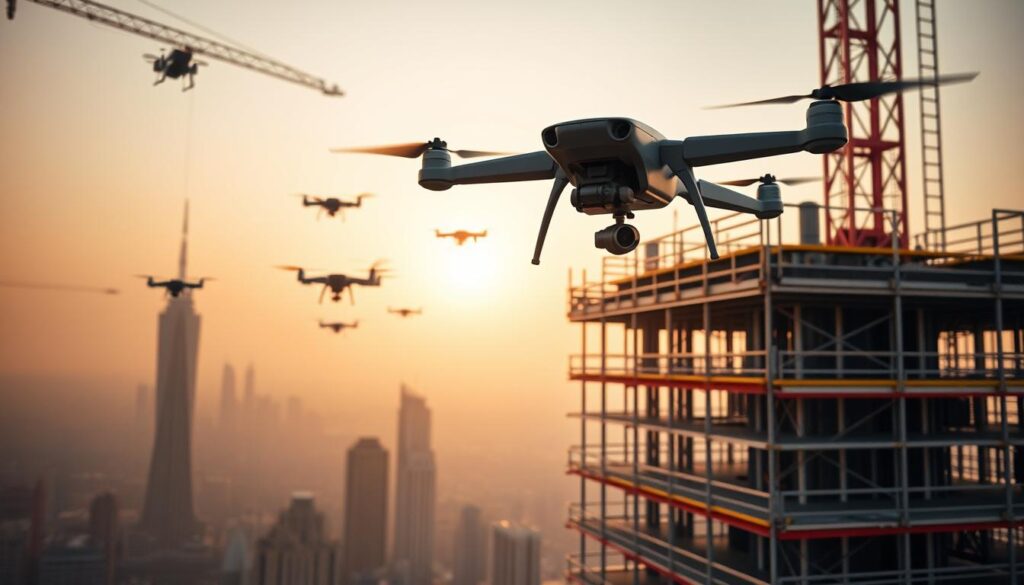
Drones are increasingly becoming a vital tool in the construction sector, enhancing efficiency and safety. The use of drones in construction projects is a prime example of innovative construction technologies in action.
Uses of Drones in Site Inspections
Drones equipped with high-resolution cameras and sensors are being utilized for site inspections, allowing for the collection of accurate data without the need for physical presence on the site. This not only improves the speed of inspections but also enhances the safety of personnel by reducing the risk of accidents.
For instance, drones can capture detailed aerial footage and photographs, which can be used to monitor project progress, identify potential issues early, and plan accordingly. As highlighted in an article on leveraging drone technology in infrastructure projects, the benefits of drones in construction are multifaceted.
Impact on Safety and Efficiency
The integration of drones in construction has a significant impact on both safety and efficiency. By enabling remote monitoring and inspections, drones reduce the need for personnel to be physically present in potentially hazardous areas, thereby improving safety.
| Aspect | Traditional Method | Drone-Based Method |
|---|---|---|
| Inspection Time | Several days | A few hours |
| Safety Risk | High | Low |
| Data Accuracy | Variable | High |
The table above illustrates the advantages of using drones over traditional methods for site inspections, showcasing improvements in time, safety, and data accuracy.
In conclusion, the adoption of drones in the construction industry is a step towards embracing AI in construction industry and other innovative technologies, leading to more efficient, safe, and cost-effective projects.
Robotics and Automation
Robotics and automation are transforming the construction landscape, enhancing efficiency and safety. The integration of these technologies is revolutionizing traditional construction practices, making them more sustainable and eco-friendly.
The Role of Robots in Construction
Robots are being increasingly used in construction for tasks such as bricklaying, demolition, and site inspection. For instance, robotic bricklayers can lay bricks at a significantly faster rate than human workers, improving construction timelines. To learn more about the latest technological advancements in construction, visit World Civil Society for insights into how these technologies are being applied in projects like bridge construction.
Potential for Improved Worker Safety
The use of robots and automation in construction also has significant implications for worker safety. By automating hazardous tasks, the risk of accidents on construction sites can be reduced. For example, robots can handle demolition work or operate in environments that are dangerous for humans, thereby enhancing overall site safety and contributing to more sustainable construction methods.
Moreover, the data collected by robots and automated systems can provide valuable insights into construction processes, helping to identify potential safety risks and implement measures to mitigate them. This proactive approach to safety is a key benefit of adopting robotics and automation in the construction industry.
Regulatory Trends and Impact

Understanding regulatory trends is essential for the successful adoption of new building technologies. The construction industry is heavily influenced by building codes, standards, and regulations that ensure safety, efficiency, and sustainability.
Understanding Building Codes and Standards
Building codes and standards are critical in shaping the construction landscape. They dictate the minimum requirements for building safety, energy efficiency, and environmental impact. Green building technologies and energy-efficient building materials are increasingly being integrated into these codes to promote sustainability.
For instance, the International Building Code (IBC) and the International Energy Conservation Code (IECC) are widely adopted standards in the USA that influence how buildings are designed and constructed. Compliance with these codes is not only mandatory but also beneficial for reducing energy consumption and environmental footprint.
Adaptation to New Technologies
As new technologies emerge, regulatory bodies are faced with the challenge of adapting codes and standards to accommodate innovations. This includes energy-efficient building materials and smart building technologies that enhance performance and reduce environmental impact.
The adaptation process involves collaboration between industry stakeholders, regulatory bodies, and technology providers. For example, the development of standards for green building technologies involves input from various parties to ensure that the technologies are safely and effectively integrated into the built environment.
Regulatory trends indicate a shift towards more stringent energy efficiency standards and the promotion of sustainable construction practices. This shift is driven by the need to reduce greenhouse gas emissions and mitigate the effects of climate change.
Smart City Initiatives
Smart city initiatives are at the forefront of urban development, leveraging advanced building technologies to create more sustainable and efficient cities. These initiatives aim to integrate various aspects of urban planning, including transportation, energy management, and public safety, to enhance the quality of life for residents.
Integration of Building Technologies in Urban Planning
The integration of building technologies in urban planning is a critical component of smart city initiatives. IoT applications in building design are enabling the creation of smart buildings that can communicate with each other and with the city’s infrastructure, optimizing energy usage and reducing waste.
This integration involves the use of advanced technologies such as Building Information Modeling (BIM) and Internet of Things (IoT) to create a more connected and efficient urban environment.
Challenges and Opportunities
While smart city initiatives present numerous opportunities for improving urban living, they also come with challenges. One of the main challenges is ensuring the cybersecurity of the interconnected systems that make up a smart city.
- Data privacy concerns
- Infrastructure costs
- Interoperability between different systems
Despite these challenges, the opportunities presented by smart city initiatives are vast. They include improved energy efficiency, enhanced public safety, and better quality of life for residents.
The Impact of Climate Change on Building Technologies
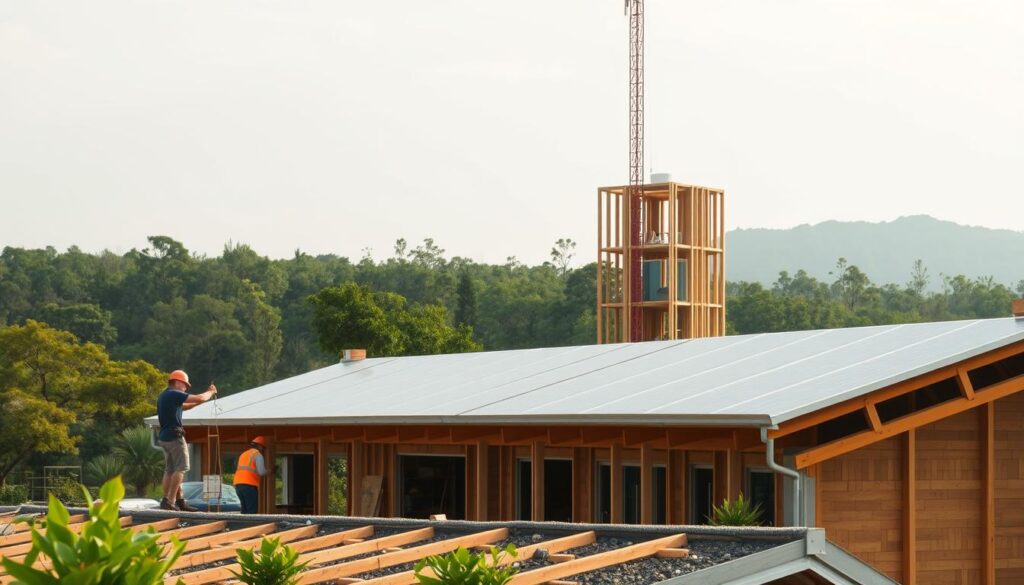
As climate change intensifies, the need for resilient and adaptive building technologies has become more pressing than ever. The construction industry is at the forefront of this challenge, driven to innovate and adopt eco-friendly construction practices that not only withstand extreme weather conditions but also contribute to reducing the carbon footprint.
Adapting to Extreme Weather
The increasing frequency and severity of weather events such as hurricanes, floods, and wildfires are compelling builders to rethink traditional construction methods. Sustainable construction methods are being adopted to enhance the resilience of buildings. This includes using materials that can withstand extreme conditions and designing structures that can adapt to changing environmental conditions.
For instance, buildings in flood-prone areas are being designed with elevated foundations, while those in high-wind areas are being constructed with reinforced structures. Moreover, the integration of smart technologies allows for real-time monitoring and adaptation to weather conditions, further enhancing building resilience.
Innovations for Climate Resilience
Innovation is key to developing climate-resilient building technologies. Advances in materials science have led to the development of new materials that are not only sustainable but also offer enhanced durability and resistance to extreme weather. For example, the use of advanced concrete materials that can self-heal cracks or materials that provide better insulation against extreme temperatures.
- Green roofs that provide insulation and reduce urban heat island effects
- Advanced glazing technologies that improve energy efficiency
- Innovative water management systems that reduce the risk of flooding
These innovations are crucial for creating buildings that are not only resilient to climate change but also contribute to a more sustainable future.
Future Outlook: Where is the Industry Heading?
With technological innovation accelerating, the construction industry is poised for significant change. The integration of AI in the construction industry is expected to revolutionize project management, enhance productivity, and improve safety standards.
The future of construction will be shaped by several innovative construction technologies. These include advanced materials, robotics, and digital twins, which will transform the way buildings are designed, constructed, and operated.
Predictions for Next-Generation Technologies
Several next-generation technologies are expected to make a significant impact on the construction industry. These include:
- Artificial Intelligence (AI) for predictive analytics and project management.
- Internet of Things (IoT) for real-time monitoring and smart buildings.
- 3D printing for rapid construction and reduced waste.
- Advanced materials that offer improved sustainability and durability.
The adoption of these technologies will lead to increased efficiency, reduced costs, and enhanced sustainability in construction projects.
| Technology | Application | Benefit |
|---|---|---|
| AI | Predictive analytics, project management | Improved efficiency, reduced costs |
| IoT | Real-time monitoring, smart buildings | Enhanced sustainability, improved safety |
| 3D Printing | Rapid construction | Reduced waste, faster project completion |
Key Players Shaping the Future
Several key players are driving the adoption of next-generation technologies in the construction industry. These include technology companies, construction firms, and research institutions that are collaborating to develop and implement innovative solutions.
Some of the notable companies leading the charge include:
- Technology giants like Google and Microsoft, which are developing AI and IoT solutions.
- Construction companies like Bechtel and Turner Construction, which are adopting and integrating new technologies.
- Research institutions and startups that are innovating and pushing the boundaries of what is possible.
The collaboration between these entities will be crucial in shaping the future of the construction industry.
Conclusion: Embracing the Future of Building Technologies
The construction industry is on the cusp of a revolution, driven by next-generation building technologies that promise to transform the way we design, build, and manage buildings. As we’ve explored, sustainable construction methods and green building technologies are at the forefront of this change.
Staying Ahead of the Curve
Staying informed about the latest technological advancements is crucial for industry professionals to remain competitive and contribute to a more sustainable future. By embracing innovations like Building Information Modeling (BIM), 3D printing, and energy-efficient systems, professionals can drive growth and reduce environmental impact.
Action for a Sustainable Future
Industry professionals must continue to adapt and evolve, leveraging sustainable construction methods and green building technologies to create a better future for generations to come. By doing so, we can create buildings that not only minimize environmental footprint but also enhance the quality of life for occupants.
